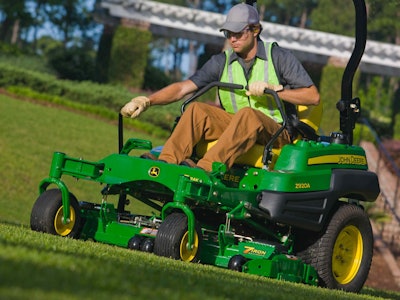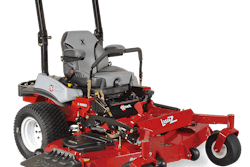 Photo: John Deere
Photo: John DeereYou did exactly what you were supposed to do last fall when winterizing your equipment. Or maybe not. A busy season or early snow may have kept you from accomplishing what you should have to put your mowers away for a long winter’s nap. That’s why it’s even more important to perform maintenance now before the season starts.
Preventive care isn’t simply about making equipment last. “Obviously, maintenance is important to the motor’s lifespan,” says Kyle Webb, CLP, A to Z Lawn & Landscaping, Inc. in Centerville, Ohio. “But it’s really about downtime. Nothing costs me more. You either pay a little now or a lot later if you break down and are scrambling without equipment.”
A once-over on a mower takes roughly one to four hours. Some companies send units to a dealer for maintenance, which runs $70 to $100 per hour. Others hire a dedicated in-house mechanic. Some companies train their own crews. “We have a chart of each machine with a checklist,” says Mike Kukol, president of Horizon Landscape in Wyckoff, New Jersey. “The benefit is we keep our people employed, and they develop a sense of ownership of the equipment they’re going to use.”
Whether you have one machine or a fleet, follow these general tips to keep your mowers humming all season long:
Prep the engine
 Photo: John Deere
Photo: John DeereGenerally, the same maintenance tasks are needed for riding mowers and walk-behinds, although at slightly different intervals. Much of what you need to do to keep your machines running well is common sense: Drain old fuel; change the oil; replace the spark plug, and install a new air filter. “Clogged filters have a negative effect on fuel efficiency,” says Christine Chapman, Kubota turf product manager. “Always start the season with a new filter, no matter what.”
Manufacturers recommend an oil and filter change periodically during the season, usually around the 100 hour-mark or 25 hours for walk-behinds. You may need more frequent intervals if you typically operate in a dusty environment. As mundane as it sounds, read your owner’s manual on all specific maintenance tasks as each manufacturer has slightly different recommendations.
In addition, remember that newer air-cooled engines require a different maintenance philosophy. “Every year, engines are required to run leaner and produce fewer hydrocarbons, so a new engine may run hotter than the same model engine built last year,” says Glenn Holland, commercial product support specialist, Gas ZTraks, with John Deere. “The amount of heat your engine produces will increase, so check oil levels daily.”
Service major systems
Replace tires if worn, and keep properly inflated. “Cut quality is affected by tire pressure,” says Holland. “If you don’t have tires at the specified PSI or if they’re too high or low from left to right or front to back, the deck level will be off. That could cause problems such as a scalp cut or visually unappealing cut.”
Grease zerks and moving parts because “lack of lubrication can actually lead to breaks in some parts of the machine such as the spindle and axles,” says Chapman.
Replace damaged belts. Look for cracks or fraying, missing chunks or stretched belts that can’t be adjusted properly. Recheck belt tension every couple of weeks. New belts may need readjusted after a wear-in period.
Check the battery. If it’s been idle for months, it may need charged or replaced.
Inspect and adjust brake systems. Perform a check of all safety systems to ensure sure the engine shuts off if you let go of the handles, for example. “You don’t want anyone getting hurt on your watch, and you don’t want a worker’s comp claim,” says Webb.
Sharpen the blades
 Photo: John Deere
Photo: John DeereEach manufacturer has specific recommendations, but various factors affect how often you’ll need to perform this task. “If you live somewhere such as Florida or North Carolina, blades dull quickly due to sandy soil,” says Holland. After a harsh winter, you’ll likely run over a lot of limbs and debris during spring clean ups this year, which also dulls blades faster.
Most landscape companies sharpen blades daily to twice a week throughout the season. It’s also smart to keep a few spares. “They’re so inexpensive and they often bend, which can’t be undone,” says Webb. “We keep two to three per mower on hand so we always have a spare pre-sharpened blade ready.” Don’t forget to balance blades, as improperly balanced blades could cause deck vibration or premature failure of the bearings.
Train your crew
Even if they’re returning from last season, it’s wise to make everyone brush up on proper mower operation and safety. Reiterate the necessity of personal protective equipment such as earplugs and safety glasses. Train crews to do a visual inspection of every mower for damage and leaks before each use. Instruct them in daily maintenance chores such as checking the oil and cleaning the mower deck, and post a checklist they can reference.
No matter how well you’ve prepared, chances are the first week out in the field will offer some surprises. “We do all the prep we can, but it seems like sometimes that first day out, everything breaks,” says Kukol. “We’ve learned to build in extra time for the unexpected. Even more importantly, we keep a sense of humor, then we fix what’s broken.”










